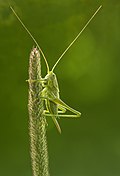| Great green bush-cricket | |
|---|---|
 | |
| T. viridissima, male | |
| Scientific classification | |
| Kingdom: | Animalia |
| Phylum: | Arthropoda |
| Class: | Insecta |
| Order: | Orthoptera |
| Suborder: | Ensifera |
| Family: | Tettigoniidae |
| Subfamily: | Tettigoniinae |
| Tribe: | Tettigoniini |
| Genus: | Tettigonia |
| Species: | T. viridissima |
| Binomial name | |
| Tettigonia viridissima | |
| Synonyms | |
| |
Tettigonia viridissima, the great green bush-cricket, [1] is a large species of bush-cricket belonging to the subfamily Tettigoniinae. [2]










